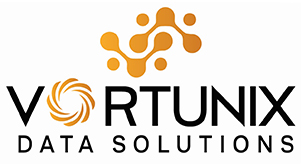What is AWS? An Introduction to Amazon Web Services
Explore the world of AWS and discover how it powers businesses through scalable and secure cloud solutions. This article breaks down key AWS components in a clear, concise manner, making it an ideal starting point for both beginners and tech professionals.
Imagine you’re running an e-commerce store that experiences a sudden spike in traffic during a big sale. Instead of scrambling to buy and set up new physical servers, you can quickly scale up your resources online. This is where cloud computing comes in, and among the many options available, AWS (Amazon Web Services) stands out as one of the leading platforms in the market.
This tutorial will demystify AWS and show you why so many businesses rely on it. We’ll look at the nuts and bolts, explore its range of services, discuss its strengths and weaknesses, and we will even take a quick look at how it compares to its competitors.
What is Cloud Computing?
Let’s quickly touch on the basics of cloud computing. But if you really want the lay of the land, take our Understanding Cloud Computing course. In simple terms, cloud computing means that instead of relying on a local server, organizations use remote servers hosted on the internet to store, manage, and process data.
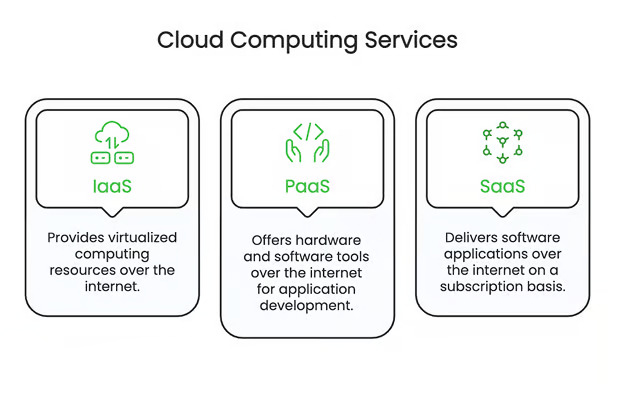
As you can see in the above infographic, Cloud computing is a broad topic. Infrastructure as a Service offers virtual servers and storage. Platform as a Service (PaaS) simplifies app development by providing the necessary tools and infrastructure. Software as a Service (SaaS) delivers fully managed applications through a subscription.
Businesses and individuals use these cloud services to enjoy flexibility, scalability, and cost savings, without the heavy upfront investment in physical hardware.
What is AWS?
AWS is Amazon’s comprehensive cloud platform that offers over 200 fully featured services from data centers around the world. Since its launch in the early 2000s, AWS has grown from an infrastructure service provider into an ecosystem that supports a wide variety of applications. Think everythone from websites and mobile apps to enterprise-level apps and IoT systems.
At its core, AWS provides a gamut of services such as computing, storage, networking, security, machine learning, analytics, and much more. This extensive portfolio powers hundreds of thousands of businesses in over 190 countries around the world.
What Makes AWS So Great
AWS stands out for several key reasons:
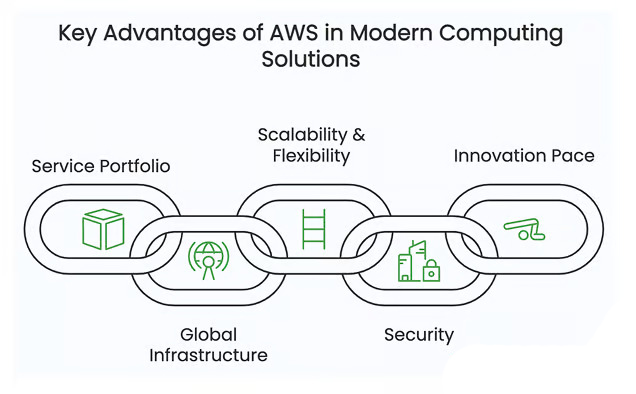
- Comprehensive service portfolio: With over 200 services, AWS covers nearly every aspect of modern computing—from data storage and databases to IoT and machine learning.
- Global infrastructure: AWS operates data centers in several regions and availability zones worldwide, ensuring fast and reliable performance regardless of your location.
- Scalability and flexibility: Scaling up and down of the resources based on demand is super easy with AWS.
- Security: AWS is known for its robust security measures, compliance certifications, and continuous monitoring. This is vital for handling sensitive data.
- Innovation pace: AWS continuously introduces new services and features, helping it users stay ahead in the competitive technology landscape
- Large community and ecosystem: A vast network of customers, partners, and third-party integrations makes AWS a thriving communityThis makes troubleshooting and learning easier.
Some of the standout services from AWS include:
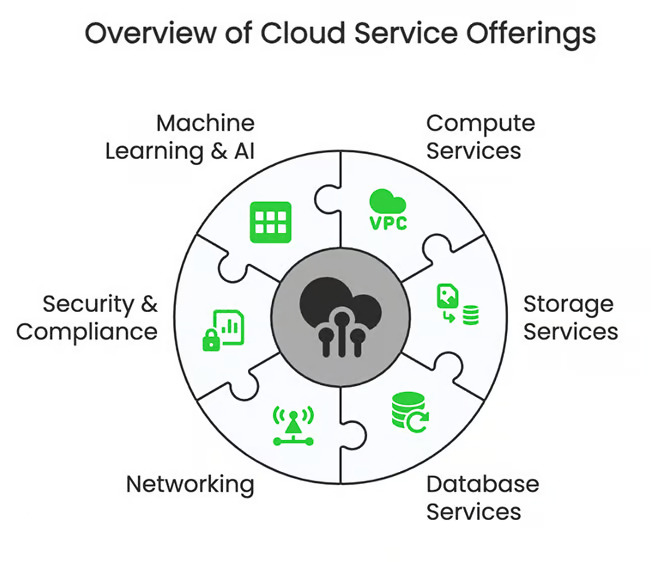
Compute services
Amazon EC2 (Elastic Compute Cloud) for flexibility and scalable computing power, and AWS Lambda to run code on demand without managing servers, so you only pay for the compute time you use.
Storage services
Amazon S3 for scalable object storage and Amazon Glacier for archival storage. Additionally, Amazon EBS (Elastic Block Store) provides high-performance block storage for applications that require frequent read and write access.
Database services
AWS manages several database solutions like Amazon RDS for relational databases and DynamoDB for fast and flexible NoSQL. In addition, its other solution, Amazon Aurora, combines the performance of high-end commercial databases with the simplicity of open-source ones.
Networking
Tools such as Amazon VPC lets you create a private network within AWS, giving you complete control over your cloud environment. AWS Direct Connect offers a dedicated network connection for a more reliable and faster experience, while Amazon CloudFront is a content delivery network (CDN) that speeds up the delivery of your content globally.
Security & Compliance
Services like AWS Identity and Access Management (IAM) helps you control who can access your resources, while another service, AWS Shield, protects against distributed denial-of-service (DDoS) attacks.
Other services
A variety of specialized services for machine learning, Internet of Things (IoT), analytics, and developer tools are available with AWS. The popular one for ML is AWS Sagemaker. These services help add advanced features to the applications, such as predictive analytics or smart automation, without starting from scratch. By leveraging these additional tools, you can quickly innovate and improve your business operations.
Each of these AWS services is crafted to simplify complex tasks, allowing you to build, deploy, and scale applications with ease.
What are the Advantages of Using AWS?
AWS offers several advantages that make it an attractive option for both businesses and developers:
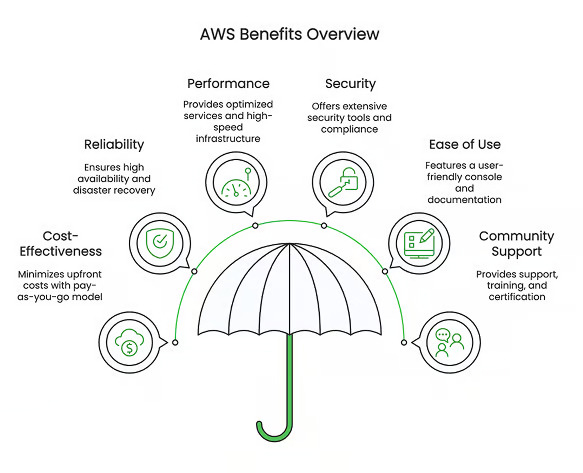
As you can see in the above infographic, one strength of AWS is that its cost-effectiveness. I’m writing this because it does have a pay-as-you-go model that minimizes upfront costs, albeit the pricing structure is confusing (which I’ll get to next). AWS is also very reliable. What I mean in particular is that is has high availability with built-in disaster recovery.
AWS is also very performant because it is optimized through high-speed infrastructure. It also is known for security, as it has over 300 compliance and governance features. It’s designed for for ease of use. If you take our AWS Cloud Technology and Services Concepts course you will see that AWS provides an intuitive management console. Last but not least, AWS’s strong community support includes training programs, certification courses, and expert assistance.
Because of these and several other advantages, it’s no surprise that Gartner recognized AWS as a Leader in the 2024 Gartner Magic Quadrant for Strategic Cloud Platform Services for the 14th consecutive year.
What are the Weaknesses of AWS?
While AWS offers many benefits, it’s important to be aware of some challenges:
- Pricing complexity: I started to mention this earlier. Because it has multifaceted pricing models and options, it can be or will be confusing for new users to estimate costs.
- Vendor lock-In: Migrating away from AWS services can be challenging once your infrastructure is heavily integrated.
- Shared responsibility: While AWS provides and ensures a secure cloud infrastructure, users bear shared responsibility for managing certain security aspects.
- Cost management: Without proper monitoring and management, usage costs can escalate unexpectedly.
- Learning curve: The sheer number of services and features means that mastering AWS can take time. Moreover, the continual introduction of new services and features requires users to educate themselves to changes within the AWS ecosystem.Luckily, DataCamp is here to help with the AWS learning curve part, offering training resources to get you started.
Real-World AWS Applications and Use Cases
AWS is used by a wide range of businesses—from startups to large enterprises—and across various industries, including:
- Automobile: AWS enabled BMW to re-architect and migrate its on-premises data lake to the cloud.
- E-commerce: During peak traffic hours, online stores heavily rely on AWS to scale quickly without downtime to ensure a smooth and reliable shopping experience.
- Media and entertainment: Streaming services need to deliver content rapidly to users around the world, and AWS makes this possible. For example, AWS provides Netflix with infrastructure allowing it to scale quickly, operate securely, and meet capacity needs anywhere in the world.
- Government and education: The AWS cloud services allow government organizations and educational institutions to modernize their IT infrastructure, support remote learning, and enhance public services while maintaining high standards of security.
- Healthcare: Managing sensitive patient data requires both strong security and compliance, and AWS delivers on both fronts.
- AI / ML: AWS supports real-time analytics and secure transaction processing, which are essential for developing AI and machine learning applications. This capability allows businesses to analyze data as it comes in and make quick, informed decisions, driving innovation in areas like predictive maintenance and personalized customer experiences.
These examples show how AWS’s flexibility and extensive service offerings make it a fit for nearly any use case.
How Someone Might Get Started with AWS
Getting started with AWS can be broken down into a simple, high-level roadmap that makes it easier for beginners to explore and learn the platform.
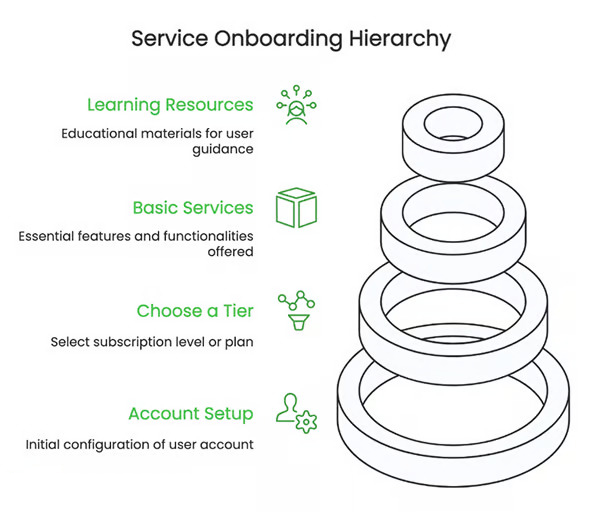
- Account Setup: Begin by visiting the AWS website and creating an account. This initial step gives you access to the full range of AWS services and sets the stage for all your future projects.
- Choose a Tier: Once your account is set up, take advantage of the AWS Free Tier, which lets you experiment with many of the core services at no cost for the first 12 months. This option is perfect for those who want to test the platform without any financial commitment, allowing them to learn and explore different services.
- Basic Services: Start with essential services such as Amazon EC2 for scalable computing power or Amazon S3 for reliable storage solutions. These services form the backbone of many applications, so exploring these will provide a solid foundation for understanding how cloud computing works on AWS.
- Learning Resources: Leverage the extensive AWS documentation and online tutorials available on the AWS website. Additionally, explore training programs and courses, such as those offered by us at DataCamp, to deepen your understanding and gain hands-on experience with the platform.
This roadmap not only helps you get started with AWS but also provides a gentle introduction to its robust platform, empowering you to gradually expand your knowledge and take on more complex projects over time.
AWS vs. Competitors
AWS is the leading player with 32% market share. However, when selecting a cloud provider, it’s important to compare them on the basis of major parameters. Here’s a quick summary comparison table of AWS with other major players like Microsoft Azure and Google Cloud Platform (GCP).

Choosing the right provider often depends on the organization’s specific needs, existing technology stack, and budget. Evaluate each option carefully to decide which aligns best with your goals.
Conclusion
In short, AWS is a comprehensive cloud platform that has changed the way businesses and developers run and scale their digital operations. Its wide range of services, global reach, and constant innovation make it a key player in cloud computing.
Even though AWS can be challenging due to complex pricing and a steep learning curve, its benefits like service offerings, security features, reliability, and performance make it a top choice for many.
Whether you’re just starting out or looking to expand your cloud expertise, consider exploring AWS further through training programs and resources like those offered by DataCamp, including our AWS Cloud Practitioner Certification, which is built as partner certification.
By understanding AWS and its offerings, you’re taking a crucial step toward leveraging the power of cloud computing in today’s digital landscape.
